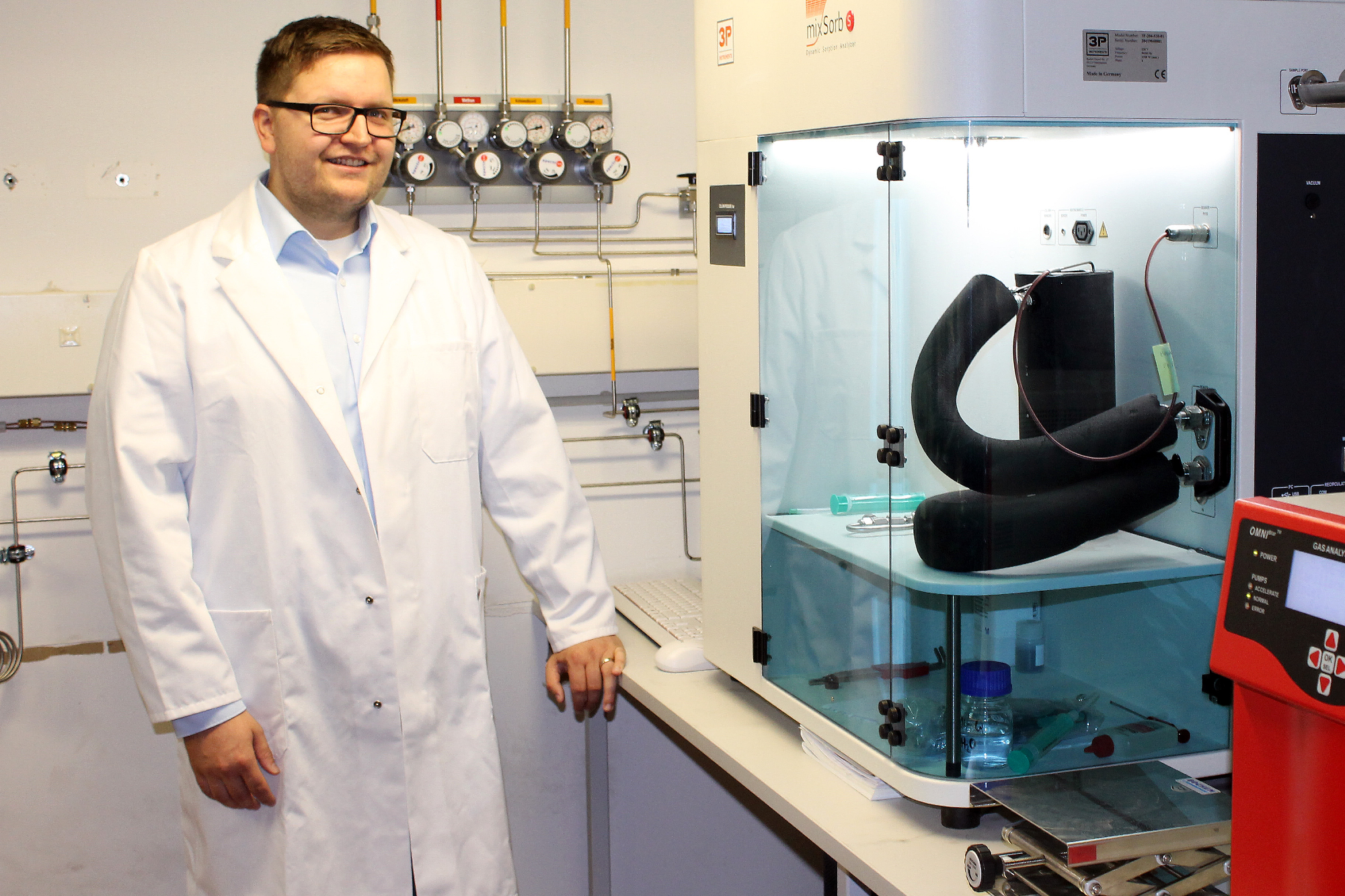Oct 21 2020
A material that could be a significant contribution to climate mitigation and sustainable industrial production has been developed by chemists at the University of Bayreuth.
 Martin Rieß, MSc, in front of the measuring system for dynamic gas adsorption in one of Bayreuth’s laboratories for Inorganic Chemistry. Image Credit: Christian Wisler.
Martin Rieß, MSc, in front of the measuring system for dynamic gas adsorption in one of Bayreuth’s laboratories for Inorganic Chemistry. Image Credit: Christian Wisler.
This material can be used to particularly separate the greenhouse gas carbon dioxide (CO2) from natural gas, industrial waste gases, or biogas, and thus made accessible for recycling.
The separation method is energy efficient and economical. In the Cell Reports Physical Science journal, the team has described the structure and function of the material.
The “Green Deal,” introduced by the European Commission in 2019, requests for the net emissions of greenhouse gases in the EU to be brought down to zero by 2050. This necessitates advanced processes that can remove and retain CO2 from waste gases and other gas mixtures so that it is not emitted into the atmosphere.
The material created by the Bayreuth team has one major advantage over earlier separation processes: It can completely remove CO2 from gas mixtures without having to chemically bind CO2. These gas mixtures can be discarded gases from industrial plants, but also biogas or natural gas.
In all these scenarios, CO2 collects in the cavities of the material exclusively because of physical interaction. From that point, it can be discharged without spending much energy, to be made accessible again as a resource for industrial manufacture.
Hence, the separation method is effective, chemically speaking, based on the principle of physical adsorption. Similar to an expansive storage tank, the new material can be packed with and emptied of CO2 in an energy-efficient manner.
In Bayreuth laboratories, it was engineered in such a manner as to just separate CO2 and not any other gas from the most diverse gas mixtures.
Our research team has succeeded in designing a material that fulfils two tasks at the same time. On the one hand, the physical interactions with CO2 are strong enough to free and retain this greenhouse gas from a gas mixture. On the other hand, however, they are weak enough to allow the release of CO2 from the material with only a small amount of energy.
Martin Rieß, MSc, Study First Author and Doctoral Researcher, Inorganic Chemistry I Research Group, University of Bayreuth
The new material is an inorganic-organic combination. The chemical foundation is clay minerals comprising hundreds of separate glass plates. The plates have a thickness of just 1 nm and are set exactly one above the other.
Organic molecules distributed between the glass plates serve as spacers. Their chemical properties and shape have been chosen such that the formed pore spaces are ideally customized to collect CO2.
Only CO2 molecules can enter into the material’s pore system and get retained there. Conversely, nitrogen, methane, and other exhaust gas components stay outside because of the size of their molecules. The team has used what is called the molecular sieve effect to boost the selectivity of the material for CO2.
At present, they are looking at the development of a clay minerals-based membrane system, engineered to enable nonstop, selective, and energy-efficient separation of CO2 from gas mixtures.
The development of a hybrid material custom-made for the removal and supply of CO2 was feasible because of a dedicated measuring system installed in the Bayreuth laboratories, which enables the exact determination of amounts of adsorbed gases and the selectivity of the adsorbing material. This has facilitated the realistic replication of industrial processes.
All criteria relevant to the evaluation of industrial CO2 separation processes have been completely fulfilled by our hybrid material. It can be produced cost-effectively, and stands to make an important contribution to reducing industrial carbon dioxide emissions, but also to the processing of biogas and acidic natural gas.
Martin Rieß, MSc, Study First Author and Doctoral Researcher, Inorganic Chemistry I Research Group, University of Bayreuth
Journal Reference:
Rieß, M., et al. (2020) Diammonium-Pillared MOPS with Dynamic CO2 Selectivity. Cell Reports Physical Science. doi.org/10.1016/j.xcrp.2020.100210.
Source: https://www.uni-bayreuth.de